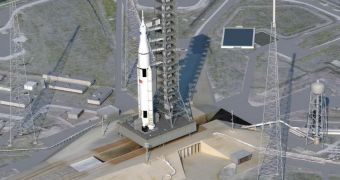Recently, the American space agency unveiled its newest rocket design. Dubbed the Space Launch System (SLS), the new heavy-lift vehicle was bound to cause controversy among experts. Now, scientists weigh in on the specific capabilities the SLS will deploy to the field.
The new rocket will include both Space Shuttle Program and Project Constellation components. The existing systems were cannibalized for proven hardware in order to reduce development and operations costs, which are already shaping up to be rather large.
The core stage of the rocket will use 5 of the SSP's RS-25D/E engines, which burn liquid hydrogen and liquid oxygen. The famous J-2X engines will go on the SLS's upper stage, NASA announced. The agency plans to conduct the first developmental flight by the end of 2017.
In addition, two Solid Rocket Boosters (SRB) like the ones the space shuttles used will be strapped to either side of the SLS, so as to give it more thrust. The largest versions of the platform will be able to carry between 70 and 129 tons (150,000 to 280,000 pounds) in low-Earth orbit (LEO).
“All of us who are interested in the future advancement of space exploration applaud any efforts to expand launch capabilities. If the nation can afford a large rocket like the SLS, it would be very useful in the long run,” former NASA shuttle program manager Wayne Hale weighs in.
“For some reason we’ve been told that it’s either Heavy-Lift or access to LEO. If we ever want to go beyond LEO again – we need heavy lift,” former NASA astronaut Kent Rominger explains. He is now the vice-president for Test and Research Operations at Alliant Techsystems (ATK).
Many analysts are now wondering whether Congress and the White House will indeed support the development of the SLS. Estimates indicate that the entire development program will cost about $18 billions by 2017, or about $3 billion per year. This includes the $10 billion needed for all components.
However, when Project Constellation was scrapped in 2010, not many in Congress were excited about it. There is a great deal of political influence in NASA's new direction for space exploration, as compiled in the 2010 National Space Policy.
“On the surface, it doesn’t seem like much, if anything new, in the way of technology. So why is it going to take so long to get it into testing and flight – NASA did the Apollo evolution faster, and it was pretty much new technology,” former NASA astronaut Robert Springer says.
“Even the proposed look at liquid boosters is hardly new; [the] MSFC had several contracts with industry to look into this technology back in the 1990’s,” adds the expert, who is now at Boeing, quoted by Universe Today.
“There are likely other areas of technology enhancement that will be included, but again, I am relatively sure that a lot of the technology (new power storage devices, something other than hydrazine for control jets, improved monitoring systems, etc) has or is being looked at,” he concludes.

 14 DAY TRIAL //
14 DAY TRIAL //